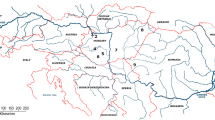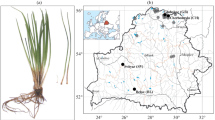Abstract
The genetic differentiation of endemic nile perch (Lates stappersi) populations in Lake Tanganyika was studied using RAPD. DNA was extracted from alcohol stored muscle tissue by a salting method, without organic solvents. Three primers amplified 58 variable DNA fragments from 270 individuals from five localities. The genetic distances of local samples as inverse of bandsharing ranged from 0.097 to 0.312. The population sampled in Kigoma, close to the estuary of the Malagarazi river showed high values of genetic distance in pairwise comparisons with other sampled populations. Principal component analysis separated the main population and the 25 samples from Kigoma with high eigenvalues. Five individuals sampled in Kigoma were united with the main population, as confirmed by significant differences in band frequences. The local population in Kigoma had significantly different frequencies in 24 RAPD bands when compared to the pooled samples of Lates stappersi. No clearly diagnostic fragments were found. The genetic distance (1-F) between the Kigoma population and the united main stock was 0.195. Based on Slatkin's index on private alleles, the level of migration between Kigoma and all other sampling sites united, migration is restricted (Nm = 0.43) and allows genetic separation.
Similar content being viewed by others
References
Aro, E. & P. Mannini, 1995. Results of fish population biology studies on Lake Tanganyika in July 1993–June 1994. FAO/FINNIDA Research for the Management of the Fisheries on Lake Tanganyika. GCP/RAF/271/FIN-TD/XX(En): 21pp.
Bernatchez, L., 1997. Mitochondrial DNA analysis confirms the existence of two glacial races of rainbow smelt Osmerus mordax and their reproductive isolation in the St Lawrence river estuary (Quebec, Canada). Mol. Ecol. 6: 73–83.
Bielawski, J. P. & D. E. Pumo, 1997. Randomly ampilified polymorphic DNA (RAPD) analysis of Atlantic Coast striped bass. Heredity 78: 32–40.
Boulenger, G. A., 1914. Mission Stappers au Tanganika-Moero. Diagnoses de poissons nouveaux: I Acanthoptérygiens, Opisthomes, Cyprinodontes. Rev. Zool. bot. afr. 3: 442–447.
Carvalho, G. R. & L. Hauser, 1994. Molecular genetics and the stock concept in fisheries. Rev. Fish Biol. Fish. 4: 326–350.
Crosetti, D., W. S. Nelson & J. C. Avise, 1994. Pronounced genetic structure of mitochondrial DNA among populations of the circumglobally distributed grey mullet (Mugil cephalus). J. Fish Biol. 44: 47–58.
Dinesh, K. R., T. M. Lim, K. L. Chua, W. K. Chan & V. P. E. Phang, 1993. RAPD analysis: an efficient method of DNA fingerprinting in fishes. Zool. Sci. 10: 849–54.
Ellis, C. M. A., 1978. Biology of Luciolates stappersi in Lake Tanganyika (Burundi). Trans. Am. Fish. Soc. 107: 557–566.
Grant, W. S. & F. M. Utter, 1984. Biochemical population genetics of Pacific herring (Clupea pallasi). Can. J. Fish. Aquat. Sci. 41: 856–864.
Hadrys, H., M. Balick & B. Schiewater, 1992. Application of random amplified polymorphic DNA (RAPD) in molecular ecology. Mol. Ecol. 1: 55–63.
Hedgecock, D., E. S. Hutchinson, G. Li, F. L. Sly & K. Nelson, 1994. The central stock of northern anchovy (Engraulis mordax) is not a randomly mating population. CalCOFI Rep. 35: 121–136.
Isabel, N., J. Beaulieu & J. Bousquet, 1995. Complete congruence between gene diversity estimates derived from genotypic data at enzyme and random amplified polymorphic DNA loci in black spruce. Proc. Natn. Acad. Sci. U.S.A. 92: 6369–6373.
Jørstad, K. E., D. P. F. King & G. Naevdal, 1991. Population structure of Atlantic herring, Clupea harengus L. J. Fish Biol. 39A: 43–52.
Miller, S. A., D. D. Dykes & H. F. Polesky, 1988. A simple salting– out procedure for extracting DNA from human nucleated cells. Nucleic Acids Res. 16: 1215.
Naish, K. A., M. Warren, F. Bardacki, D. O. F. Skibinski, G. R. Carvalho & G.C. Mair, 1995. Multilocus fingerprinting and RAPD reveal similar genetic relationships between strains of Oreochromis niloticus (Pisces: Ciclidae). Mol. Ecol. 4: 271–274.
Nei, M & W. H. Li, 1979. Mathematical model for studying genetic variation in terms of restriction endonucleases. Proc. Natn. Acad. Sci. U.S.A. 76: 5269–5273.
Norušis, M. J., 1995. SPSS® for WindowsTM. Advanced statistics, release 7.0. SPSS Inc. Chicago, Illinois, USA: 580 pp.
Park, L. K. & P. Moran, 1994. Developments in molecular genetic techniques in fisheries. Rev. Fish Biol. & Fish. 4: 272–299.
Rice, W. R., 1989. Analyzing tables of statistical tests. Evolution 43: 223–225.
Roest, F. C., 1985. Predator-prey relations in northern Lake Tanganyika and fluctuations in the pelagic fish stocks. United Nations Food and Agriculture Organization, CIFA Symposium SAWG/85/WPI: 1–28.
Skroch, P. & J. Nienhuis, 1995. Impact of scoring error and reproducibility of RAPD data on RAPD based estimates of genetic distance. Theor. Appl. Genet. 91: 1086–1091.
Slatkin, M. & N. H. Barton, 1989. A comparison of three indirect methods for estimating average levels of gene flow. Evolution 43: 1349–1368.
Sokal, R. R. & F. J. Rohlf, 1981. Biometry. Freeman, San Francisco: 859 pp.
Smith, P. J., A. Jamieson & A. J. Birley, 1990. Electrophoretic studies and stock concept in marine teleosts. J. Cons. Int. Explor. Mer. 47: 231–45.
Szmidt, A. E.,W. R. Wang & M. Z. Lu, 1996. Empirical assessmentof allozyme and RAPD variation in Pinus sylvestris (L.) using haploid tissue analysis. Heredity 76: 412–420.
Tiercelin, J.-J. & A. Mondeguer, 1991. The geology of the Tanganyika Trough. In: G. W. Coulter (ed.), Lake Tanganyika and its Life. British Museum (Natural History): 7–48.
Tringali, M. D. & R. R. Jr., Wilson, 1993. Differences in haplotype frequencies of mtDNA of the Spanish sardine Sardinella aurita between specimens from the eastern Gulf of Mexico and Southern Brazil. Fish. Bull. U.S. 91: 362–370.
Williams, J. G. K., A. R. Kubelik, K. J. Livak, J. A. Rafalski & S. V. Tingey, 1990. DNA-polymorphisms amplified by arbitrary primers as useful genetic markers. Nucleic Acids Res. 18: 6531-6535.
Yu, K. & K. P. Pauls, 1993. Optimization of the PCR program for RAPD analysis. Nucleic Acids Res. 20(10): 2606.
Author information
Authors and Affiliations
Rights and permissions
About this article
Cite this article
Kuusipalo, L. Genetic differentiation of endemic nile perch Lates stappersi (Centropomidae, Pisces) populations in Lake Tanganyika suggested by RAPD markers. Hydrobiologia 407, 141–148 (1999). https://doi.org/10.1023/A:1003797700309
Issue Date:
DOI: https://doi.org/10.1023/A:1003797700309




